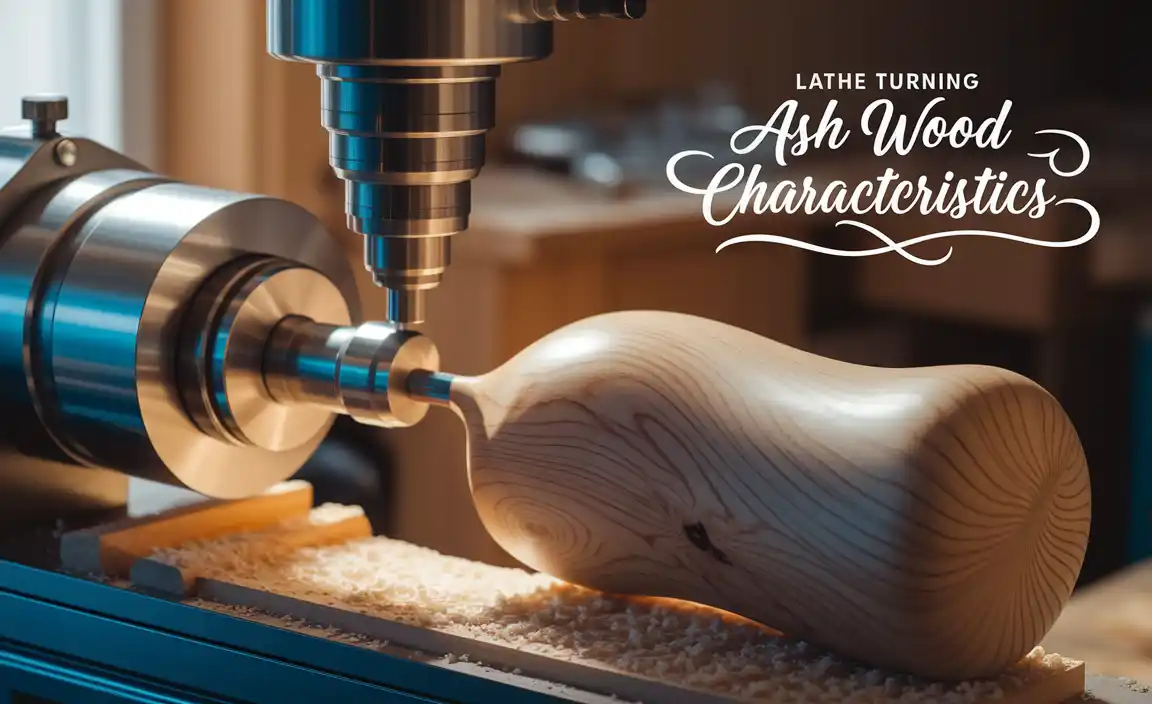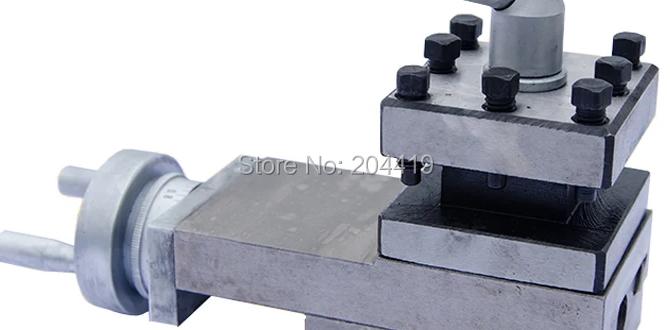A 1/8-inch carbide end mill is your go-to for dry cutting A2 tool steel, offering precision and durability without needing coolant. This guide simplifies its use for beginners, ensuring clean cuts and great results for your projects.
Welcome to Lathe Hub! If you’ve ever looked at a piece of A2 tool steel and felt a bit intimidated by cutting it, you’re not alone. This tough material is fantastic, but it can be a real challenge to work with, especially if you don’t have a lot of experience or the right setup. The good news is, with the right tool, it becomes much more manageable. We’re going to dive into the world of the 1/8-inch carbide end mill, a tiny but mighty tool that’s like a secret weapon for dry cutting A2.
Imagine tackling those precise cuts, those intricate shapes, or just getting a clean edge without any coolant splashing around and making a mess. That’s exactly what this little end mill is designed for. It’s perfect for hobbyists and beginners who are just getting their feet wet in machining or upgrading their home workshop. We’ll break down exactly what makes this end mill so special, how to use it safely, and what kind of results you can expect.
So, grab your safety glasses, and let’s get started unraveling the mystery of the 1/8-inch carbide end mill. By the end of this, you’ll feel much more confident about taking on A2 tool steel and achieving those professional-looking finishes you’ve been aiming for. Ready to learn how this essential tool can transform your machining?
Why A2 Tool Steel Needs the Right End Mill
A2 tool steel is a popular choice for a reason. It balances toughness, wear resistance, and hardness exceptionally well, making it ideal for tooling, dies, punches, and other demanding applications. However, this very toughness is what makes it difficult to machine. If you don’t use the right tools and techniques, you can face a number of frustrating problems.
Heat Build-up: A2 tool steel generates a lot of heat when machined. Without proper cooling, this heat can quickly damage your cutting tool, making it wear out faster or even break. It can also cause distortion in your workpiece.
Tool Wear: Standard high-speed steel (HSS) end mills can struggle significantly with A2. They can dull quickly, leading to poor cut quality and requiring frequent replacements.
Chip Welds: When materials are machined too hot, chips can weld themselves to the cutting edge of the tool. This ruins the cutting edge and makes for a very messy, inefficient cut.
Surface Finish Issues: If your tool isn’t cutting cleanly, you’ll end up with a rough or smeared surface finish, which might require extensive post-machining work.
This is where a specially designed carbide end mill comes into play, particularly for dry cutting. Let’s look at what makes it so effective.
Carbide vs. HSS: The Dry Cutting Advantage
When we talk about machining tough materials like A2 tool steel, the material of your cutting tool is crucial. High-Speed Steel (HSS) was the standard for a long time, and it’s still great for many jobs. However, for dry cutting hardened steels, carbide offers significant advantages.
| Feature | Carbide End Mill | High-Speed Steel (HSS) End Mill |
|---|---|---|
| Hardness | Excellent (can withstand higher temperatures) | Good, but softens at higher temperatures |
| Heat Resistance | High | Moderate |
| Rigidity | More brittle, but very rigid | More flexible, can handle shock better |
| Wear Resistance | Superior | Good |
| Cost | Generally higher | Generally lower |
| Best For | Hard materials, high-volume production, dry machining of tough steels | Softer materials, general-purpose machining, tasks where tool flexibility is key |
Carbide is made from tungsten carbide particles sintered with a binder metal, usually cobalt. This composition gives it incredible hardness and the ability to maintain it at high cutting temperatures. This is precisely why a carbide end mill is often the preferred choice for dry cutting A2 tool steel. It can handle the friction and heat generated without dulling as quickly as HSS would.
The “1/8 Inch Carbide End Mill”: What You Need to Know
You might wonder why a specific size like 1/8 inch is so important. For A2 tool steel, especially in smaller-scale projects or when dealing with intricate details, a 1/8-inch end mill is incredibly versatile.
Precision: Smaller end mills allow for much finer detail work. If you’re creating small slots, pockets, or engravings, this size is perfect.
Material Removal Rate (MRR): While a larger end mill will remove material faster, a 1/8-inch end mill, when used correctly, can still be efficient for its size. It allows you to take controlled, manageable passes.
Accessibility: For many DIY and hobbyist CNC machines or milling machines, a 1/8-inch end mill is a common size that fits standard collets and is readily available.
Specific Applications: Often, when working with A2, you might be creating smaller components or needing to machine critical features where a larger tool might remove too much material or cause excessive stress.
The “1/8 Inch Carbide End Mill for Dry Cutting A2 Tool Steel” Keyword Breakdown:
Let’s break down the full keyword to understand what makes a tool suitable for this job:
“Carbide End Mill”: This tells us the material of the cutting tool – tungsten carbide, chosen for its hardness and heat resistance.
“1/8 Inch”: This specifies the diameter of the cutting head. It’s a crucial dimension for the type of cuts you can make.
“1/2 Shank”: This often refers to the diameter of the tool’s shaft, which is the part that goes into your collet or tool holder. A 1/2-inch shank is a common and robust size, providing good stability for this diameter of cutting head.
“Stub Length”: This means the end mill is shorter than a standard end mill of the same diameter. Shorter lengths are generally more rigid, which is extremely beneficial when cutting hard materials like A2. Rigidity reduces vibration and deflection, leading to better accuracy and surface finish.
“Tool Steel A2”: This clearly identifies the material being cut. A2 is known for being hard and tough.
“Dry Cutting”: This is the key operational constraint. It means the tool and process are designed to work effectively without the use of liquid coolants. This often implies specific flute geometries, coatings, and materials designed to manage the heat generated through other means (like controlled chip evacuation and the material’s own properties).
Key Features of a Good 1/8″ Carbide End Mill for A2 Dry Cutting:
When selecting your tool, look for these characteristics:
Material: Solid carbide is a must.
Flute Count: For A2 and dry cutting, 2-flute or 3-flute end mills are common.
2-Flute: Offers better chip clearance, which is vital for dry cutting to prevent chip recutting and heat build-up. It’s generally preferred for slotting and profiling.
3-Flute: Can offer a slightly better surface finish and can sometimes be run at higher feed rates, but chip evacuation can be more challenging in deep pockets. For dry cutting A2, always prioritize chip evacuation.
Coating: A specialized coating can significantly improve performance. For dry cutting hardened steels, coatings like TiCN (Titanium Carbonitride) or AlTiN (Aluminum Titanium Nitride) can enhance hardness, lubricity, and heat resistance.
Geometry:
Corner Radius: Often, end mills designed for hard materials will have a small radius on the corners to strengthen them and reduce chipping. This is less likely on a basic “square” end mill for general use but is worth noting.
Helix Angle: A higher helix angle (e.g., 30-45 degrees) can provide a sharper cutting action and better chip evacuation.
Rigidity: As mentioned, stub length contributes to rigidity by having a shorter flute length relative to its diameter. This is critical for stable machining of hard materials.
Setting Up for Success: Your Machine and Workpiece
Before we even touch the end mill, setting up your machine and workpiece correctly is paramount. This is where safety and precision begin.
Machine Considerations
Rigidity is Key: Your milling machine needs to be rigid. Any flex or vibration will be amplified when cutting hard materials like A2, leading to poor finish, tool breakage, or even damage to your machine. Ensure your machine is well-maintained, with no excessive play in the leadscrews or spindle.
Spindle Speed (RPM) and Feed Rate: These are critical parameters. For dry cutting with a 1/8-inch carbide end mill in A2, you’ll generally be looking at higher spindle speeds and relatively slower feed rates compared to softer materials.
Collet/Tool Holder: Use a high-quality collet or tool holder to ensure the end mill is held securely and runs true. Runout (wobble) in the spindle can dramatically shorten the life of your end mill and ruin your cut. A dedicated milling collet chuck (like a milling chuck or hydraulic chuck) is best for holding end mills precisely. For hobbyists, a good quality ER collet chuck is a common and effective choice.
Axis Control: A CNC mill offers the most controlled approach. If you’re using a manual mill, take your time with hand-feeding, especially on depth.
Workpiece Clamping
Secure Hold: Your A2 tool steel workpiece must be clamped down very securely. If it moves even slightly during the cut, it can ruin the part and be extremely dangerous.
Support: Ensure the workpiece is well-supported underneath to resist the upward forces of the milling operation. Use parallels or risers if necessary.
Avoid Overhang: Minimize any overhang of the workpiece from your vise or clamping system.
Step-by-Step Dry Cutting with a 1/8″ Carbide End Mill in A2 Tool Steel
Now, let’s get to the actual cutting process. Remember, patience and attention to detail are your best friends here.
Step 1: Gather Your Tools and Safety Gear
Before you start, make sure you have everything ready:
1/8″ Solid Carbide End Mill: Specifically designed for hardened steel and dry cutting, ideally with a coating like TiCN or AlTiN. A stub-length, 2-flute is often a good choice for this application.
Milling Machine: With a functional spindle and controls.
Collet Chuck or Tool Holder: To hold the end mill securely.
High-Quality Collets: To match your end mill shank.
A2 Tool Steel Workpiece: Properly prepared and cleaned.
Vise or Clamping System: Strong and suitable for your machine.
Safety Glasses/Face Shield: Absolutely essential.
Hearing Protection: Milling can be loud.
Dust Collection System (Optional but Recommended): Dry cutting produces fine dust, which is best managed.
Deburring Tool or File: For cleaning up edges after.
Calipers and Measuring Tools: For accuracy.
Depth Micrometer or DRO (Digital Readout): For precise depth control.
Step 2: Install the End Mill and Workpiece
1. Clean Everything: Ensure your collet, collet chuck, and the end mill shank are clean and free of any oil or debris.
2. Insert the End Mill: Place the 1/8″ end mill into the collet. Ensure it’s seated fully. Tighten the collet according to the manufacturer’s instructions and then tighten the collet chuck or tool holder’s retaining nut securely.
3. Install Workpiece: Clamp your A2 tool steel workpiece firmly in the vise. Ensure it’s square and positioned correctly for your planned cuts. Use parallels under the workpiece in the vise jaws to allow for the cutter to pass below the top surface without hitting the vise.
Step 3: Determine Cutting Parameters (RPM and Feed Rate)
This is one of the most crucial steps. Default values might exist for general milling, but A2 tool steel and dry cutting are specific. Here’s a guideline, but always consult your end mill manufacturer’s recommendations if available.
Surface Speed (SFM): For carbide in A2 steel, you might start in the range of 200-400 SFM (Surface Feet per Minute).
Chipload: This is the thickness of the chip each tooth takes. For a 1/8″ carbide end mill in A2, a starting chipload might be around 0.001″ to 0.002″ per tooth.
Calculations:
Spindle Speed (RPM) = (SFM 3.82) / Diameter (in inches)
For 200 SFM and a 1/8″ (0.125″) diameter: RPM = (200 3.82) / 0.125 = 6112 RPM
For 400 SFM and a 1/8″ diameter: RPM = (400 3.82) / 0.125 = 12224 RPM
Note: Many hobbyist machines might not reach these speeds. You’ll need to work within your machine’s capabilities.
Feed Rate (IPM) = RPM Number of Flutes Chipload (inches)
Using 6112 RPM, 2 flutes, and 0.001″ chipload: Feed Rate = 6112 2 0.001 = 12.2 IPM
Using 12224 RPM, 2 flutes, and 0.002″ chipload: Feed Rate = 12224 2 0.002 = 48.9 IPM
Important Note on Parameters: These are starting points. You might need to adjust based on your specific machine, end mill, and the exact condition of your A2 steel (e.g., hardness will vary). Listen to the cut. If it’s screaming or chattering, adjust your feed rate or RPM. A nice, crisp cutting sound is what you’re after.
For dry cutting A2, aim for the higher end of the RPM range your machine can achieve to help with chip evacuation and heat dissipation, and be conservative with the chipload initially.
Step 4: Setting the Z-Axis Depth
Precise depth control is essential.
1. Touch Off: Use a depth stop, edge finder, or indicator to accurately establish your Z-axis zero point on the surface of your workpiece.
2. Program/Set Depth of Cut: For each pass, you’ll typically take a shallow depth of cut. For dry cutting A2, a radial depth of cut (how much the cutter steps sideways) and an axial depth of cut (how deep it cuts into the material) should be relatively small.
Axial Depth of Cut (DOC): For A2 tool steel with a 1/8″ end mill, starting with a DOC of 0.020″ to 0.040″ is reasonable. You might be able to go deeper if your machine is very rigid and your RPM/feed are optimized, but it’s safer to start shallow.
Radial Depth of Cut (Stepover): How far the cutter moves sideways in each pass. For full slotting (milling a slot the full diameter of the end mill), your stepover is 0. This is the most demanding. For profiling (cutting around a shape), you can take a lighter stepover, perhaps 50% of the diameter (0.0625″), or even less.
Step 5: Performing the Cut
1. Engage the Spindle: Turn on your spindle to the calculated RPM.
2. Plunge (if necessary): If plunging straight down into the material, do so slowly with a controlled feed rate. Some end mills are designed for plunging, others are not. If not, you might need to use a helical interpolation (a spiral motion) to enter the material to avoid shock loading.
3. Machine the Path:
Conventional Milling: The cutter rotates against the direction of feed. This tends to lift the chip and can be a bit rougher, generating more heat.
Climb Milling: The cutter rotates in the same direction as the feed. This pushes the chip down and generally results in a smoother cut with less heat. For many CNC operations, climb milling is preferred for efficiency and surface finish. If using a manual mill, you must be very careful to eliminate backlash in the screws to avoid the cutter grabbing and lifting the machine head.
4. Chip Evacuation: Keep an eye on chip formation. For dry cutting, effective evacuation is key. If chips aren’t clearing, or you see them building up, your feed rate might be too high, or your RPM too low. Stop the machine and clear any packed chips carefully.
5. Take Multiple Passes: Don’t try to remove all the material in one go. Each pass should be







